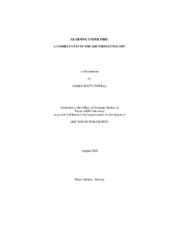| dc.description.abstract | Engaging a determined enemy across a broad range of conditions, the U.S. Army in
World War II's Southwest Pacific Area (SWPA) played an important role in the defeat of Japan.
How units fought and learned in SWPA and how they adapted to the evolving challenges of their
environment is the focus of this dissertation. The subject remains largely unexplored, especially
in contrast to the attention the European theater has received. An examination of the 112th's
performance not only illuminates an understudied area in the historiography of World War II but
also offers relevant lessons for contemporary military organizations.
Mining a rich collection of primary sources, this study analyzes the development of the
112th Cavalry Regiment and sheds light on how American units in SWPA prepared for and
conducted combat operations. A National Guard unit federalized in 1940 and sent to the Pacific
theater in 1942, the 112th performed garrison duties on New Caledonia and Woodlark Island and
eventually fought in New Britain, New Guinea, and the Philippines. Before deactivating, the
regiment also served in Japan during the first months of the occupation.
Concentrating on one unit illustrates the extent to which ground forces in SWPA were
driven to learn and adapt. The 112th had mixed success when it came to carrying out its
assigned missions effectively. The same was true of its efforts to learn and improve. The unit's
gradual introduction to combat worked to its advantage, but learning was not simply a matter of building on experience. It also involved responding to unexpected challenges. Experience
tended to help, but the variety of circumstances in which the cavalrymen fought imposed limits
on the applicability of that experience. Different situations demanded that learning occur in
different ways. Learning also occurred differently across the organization's multiple levels.
Moreover, failure to learn in one area did not, as a matter of course, undermine advancement in
all. Much depended on the presence of conditions that facilitated or disrupted the learning
process, such as the intricacy of the tasks involved, the part higher headquarters played, and the
enemy's own responses to the changing environment. | en |


